Storing cheese properly is crucial to preserve its flavour, texture and quality. Cheese is a perishable food item that can easily spoil if not stored correctly. In this blog post, we will discuss the importance of cheese storage, your equipment options and guidelines for storing different types of cheese.

SEE ALSO: The Cheese Wanker’s 10 Commandments of Cheese (for the righteous turophile) →
[Disclaimer: This post contains affiliate links. If you use these links to make a purchase, we may earn a commission (at no cost to you)]
Why is proper cheese storage important?
Proper storage of cheese is essential to maintain its safety, aroma, flavour and texture.
Health & safety
Proper storage of cheese is crucial to ensure its safety and prevent the growth of harmful bacteria. Cheese is a perishable food product that can quickly develop harmful microorganisms if not stored at the right temperature and humidity.
These microorganisms can cause foodborne illness and pose a significant risk to public health.
Preserving the cheese’s quality
Furthermore, cheese contains living microorganisms, which play a crucial role in developing its organoleptic properties. And those microorganisms require specific conditions to thrive and produce the desired flavour and texture. Therefore, it is essential to provide the right storage conditions to keep the cheese at its best.
Improper storage conditions can cause cheese to dry out, mould or spoil. Cheese can also absorb odours and flavours from its surroundings, leading to unpleasant taste and smell.
Finally, exposure to air, light and high temperatures can accelerate the deterioration process and cause the cheese to spoil quickly. You can read more about the effect of light on cheese by clicking here.
Cheese storage guidelines
While different cheeses may have different storage requirements in different conditions, there are some general guidelines that you can follow.
Where you should store cheese
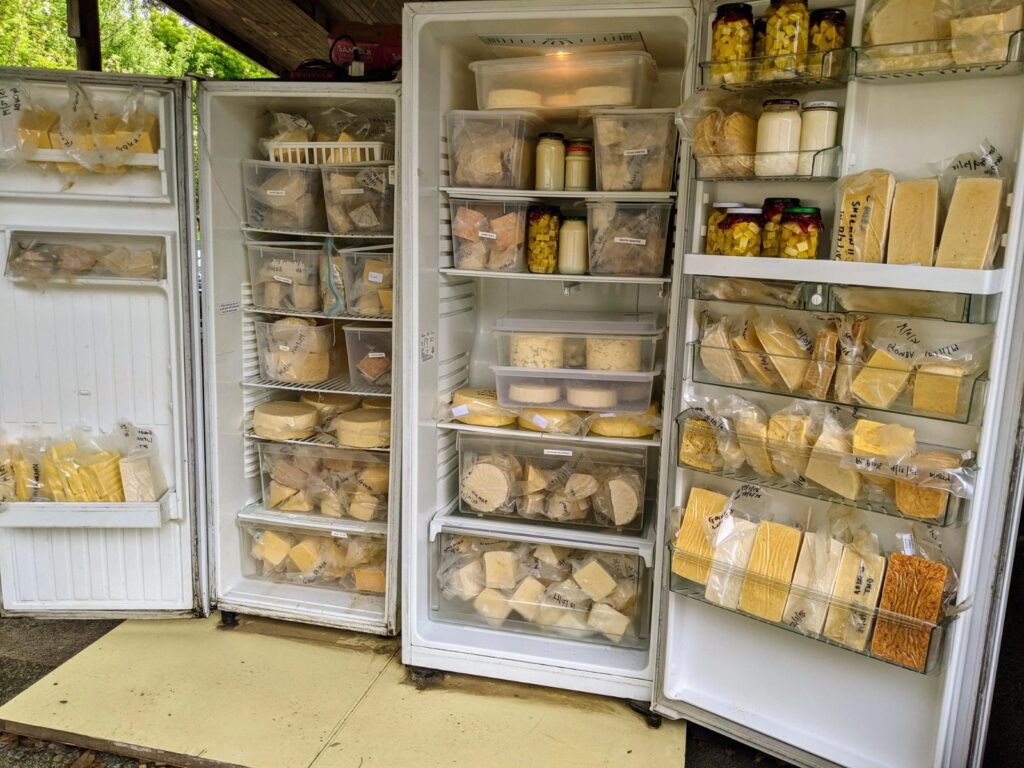
The general rule of thumb for storing cheese is to keep it in the refrigerator, preferably in the cheese drawer or airtight container.
Cheese should be stored at a temperature between 4-8°C, with the exception of fresh cheeses, which should be stored at a slightly lower temperature. It is best to store cheese in a separate container or on a separate shelf in the refrigerator to avoid cross-contamination with other food items.
While it is also safe to freeze cheese, this process will often have a detrimental effect on the cheese’s texture and flavour. You can read more about our thoughts on the matter by clicking here.
How you should wrap your cheese

And it goes without saying that you should NEVER leave cheese unwrapped in your fridge. This will dry out your piece of cheese and expose it to a number of potential contaminants. Moreover, its aroma will like spread to other items.
Cheese should be wrapped in waxed or parchment paper or a cheese-specific wrap that allows the cheese to breathe while preventing moisture and odours from affecting its quality. We’ll get back to this and cover your best options a little bit later.
How long can you keep cheese?
Undoubtedly, the shelf life of cheese varies depending on the type of cheese and its storage conditions.
Pressed cooked cheeses like Parmesan and blue cheeses like Stilton can last up to four weeks in your fridge. However, a soft white mould cheese like Brie will have a shorter shelf-life of one to two weeks. Moreover, fresh cheeses like Ricotta and Chèvre should be consumed within a few days.
As always, it is essential to check the cheese regularly for signs of spoilage, such as unwanted mould, off odours and discolouration. If it appears to be unsafe to consume, you should discard it.
Does cheese storage vary from country to country?

The guidelines for storing cheese may vary from country to country, depending on the type of cheese produced and the local climate. For example, in France, cheese is often stored at room temperature, while in the UK, it is usually kept in the refrigerator.
Furthermore, temperature and humidity levels in the room may also affect how cheese should be stored. During hot and humid summer months, cheese may spoil more quickly and should be stored at a lower temperature.
On the other hand, in winter, cheese is more likely to dry out. Hence, you should store your cheese in a more humid environment.
What equipment can you use to store cheese?
Cheese can be stored in a variety of equipment, including cheese grottoes, airtight containers and cheese bags. Let’s have a look at some of the best options.
Cheese Grotto
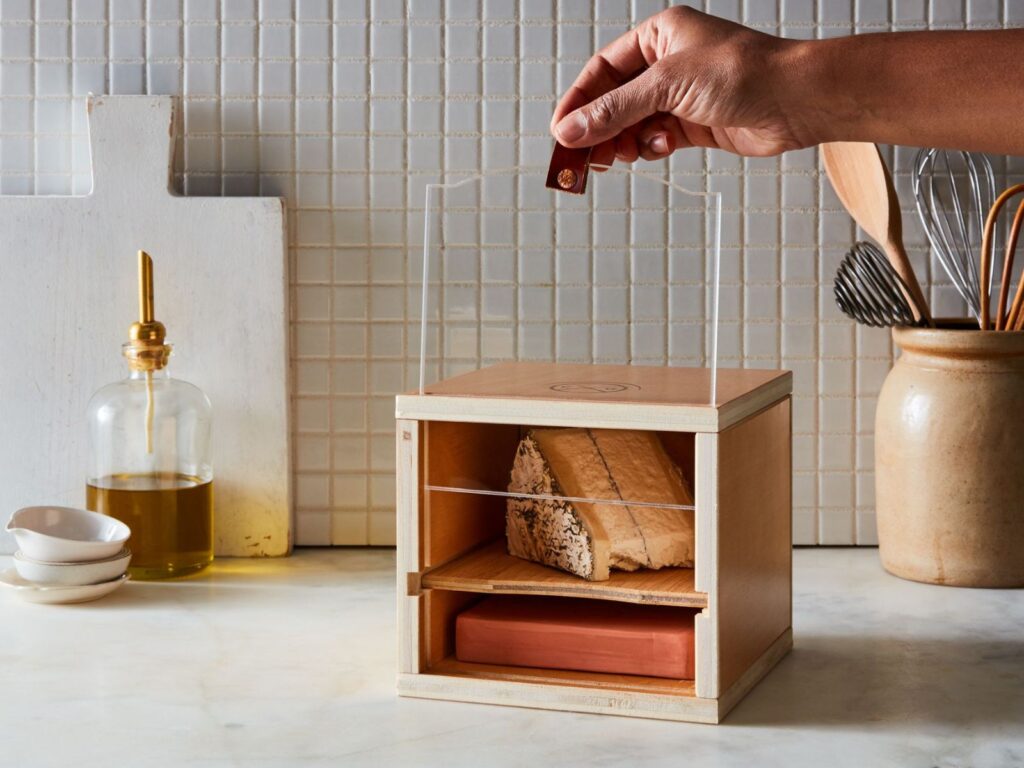
The Cheese Grotto is a unique piece of equipment designed to help cheese lovers store and age their cheese collection. It is a specialised storage unit made of wood that provides the perfect environment for storing cheese at the right temperature and humidity levels. Indeed, a clay brick at the bottom of the grotto will allow you to regulate the level of moisture.
Moreover, the Cheese Grotto comes in various sizes and shapes. And some even have drawers and shelves for storing different types of cheese separately. By controlling the humidity, it prevents moisture build-up on the cheese’s surface. And also prevents the cheese from drying out.
Without a doubt, a Grotto is a great investment for cheese enthusiasts who want to store their cheese properly and enjoy it at its best. However, it does cost a premium. And this leads us to our next option.
BUY NOW: Full-Size Cheese Grotto Classico or Compact Cheese Grotto Fresco →
Airtight plastic containers
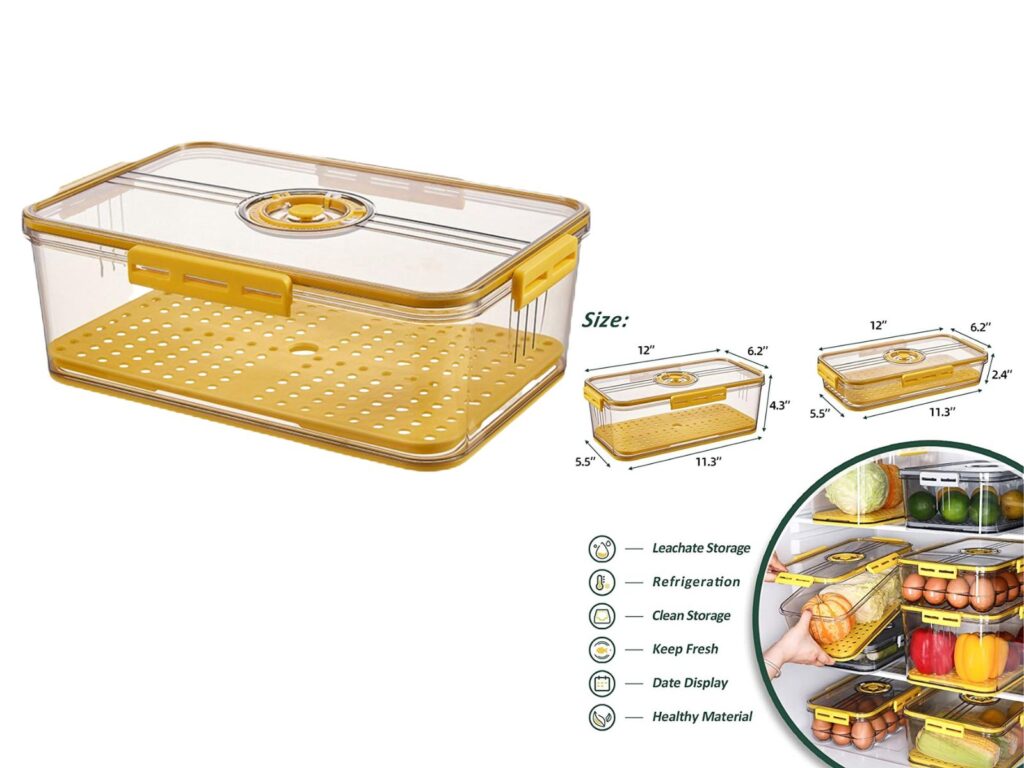
While the Cheese Grotto is an excellent option for storing cheese, it may not be practical for everyone due to its size and cost. Fortunately, there are alternative ways to store cheese at home that can produce similar results. One method is to use plastic airtight containers and pre-moistened paper towels.
To use this method, start by selecting a plastic container that is large enough to hold your cheese. Next, moisten a paper towel with water and gently wring it out so that it is damp but not soaking wet. Line the bottom of the container with the damp towel. The place the rack on top of the paper towel, and your cheese on top of the rack.
Seal the container and store it in the refrigerator. Effectively, the pre-moistened paper towel will help to regulate the humidity inside the container. Hence, it creates a controlled environment that is similar to the Cheese Grotto.
It is important to check the paper towel regularly and replace it if it becomes dry or mouldy. Also, make sure to use a container that is appropriate for the type of cheese you are storing. Harder cheeses like Cheddar can be stored in airtight containers, while softer cheeses like Camembert may require a container with some ventilation.
BUY NOW: Reusable Cheese Storage Container with Rack →
Cheese bags

Cheese bags are another option for storing cheese at home that may produce similar results to the Cheese Grotto. Cheese bags are made from a breathable material that allows the cheese to breathe while protecting it from moisture and odours. They come in various sizes and shapes, and some even have a label area for recording the type of cheese and date of storage.
To use cheese bags, start by selecting a bag that is appropriate for the type of cheese you are storing. Harder cheeses like Gouda can be stored in bags with a tight seal, while softer cheeses like Camembert may require a looser bag to allow for some ventilation.
Next, place the cheese in the bag, making sure to remove as much air as possible before sealing it. Store the bagged cheese in the refrigerator, and check it regularly to ensure that the cheese is still fresh.
While cheese bags can be a convenient option for storing cheese at home, they do have some limitations. They will not be as effective as the Cheese Grotto at regulating humidity and temperature, and they may not be suitable for long-term storage. However, for short-term storage of cheese, cheese bags can be an affordable and practical alternative to a dedicated cheese storage unit.
BUY NOW: Easy-to-Use Formaticum Cheese Storage Bags →
How to wrap cheese
The options we’ve just covered allow you to safely put away your cheese in the fridge without having to wrap it. But you may have limited space or do not want to invest in specialised equipment.
If that’s your situation, we’ve got some fantastic tips on how you can wrap your cheese and keep it at its best.
What you should use
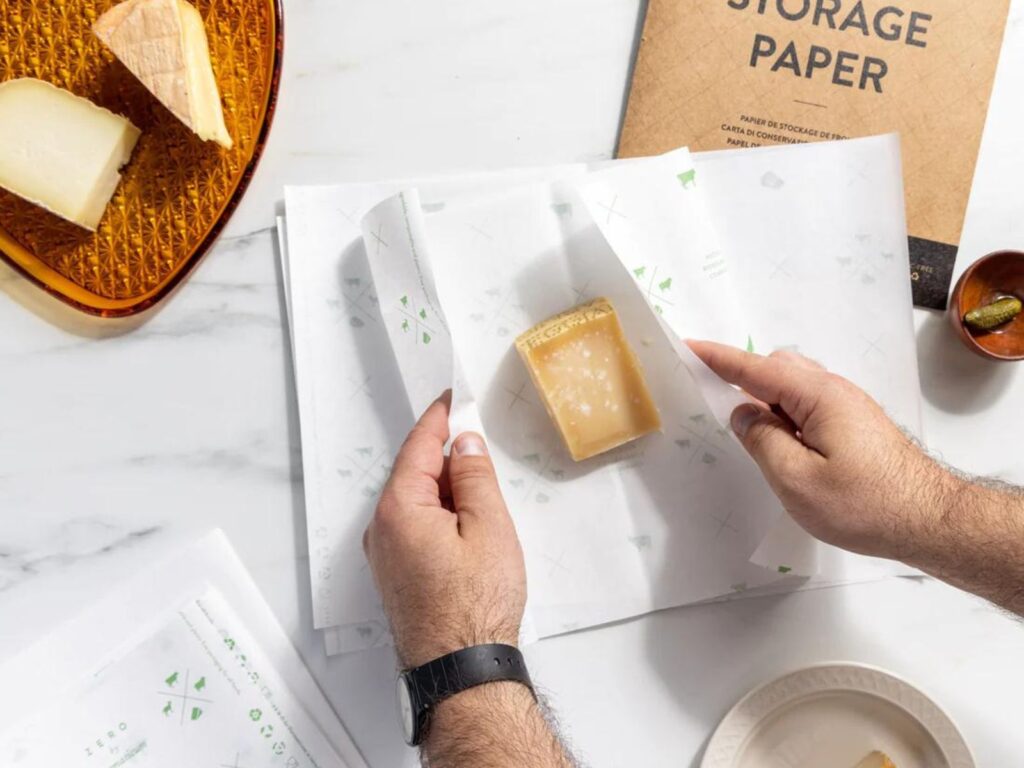
When wrapping cheese, it is essential to use the right materials to ensure that the cheese stays fresh for as long as possible. First, you want to choose a wrapping material that will allow the cheese to breathe while protecting it from moisture and odours.
Wax paper and parchment paper are popular options as they are breathable and do not stick to the cheese. Cheese-specific wrap made from muslin or coated paper is also an excellent choice as it is designed to wick away moisture and protect the cheese.
BUY NOW: Formaticum Cheese Storage Wax-Coated Paper →
Finally, aluminium foil is a great option for wrapping blue cheese. It limits the entry of oxygen into the paste of the cheese and essentially stops the activation of the blue mould. Unlike soft white mould cheeses, you do not want your blue cheese to continue ripening inside your fridge. The reason for this is because it can lead to undesirable aroma and flavour attributes.
What you should NOT use

Plastic is not an ideal material for wrapping cheese because it can trap moisture and prevent the cheese from breathing.
Consequently, this can promote the growth of harmful bacteria and mould. Additionally, plastic can give the cheese an off-flavour and unpleasant odour.
How you should wrap your piece of cheese

To wrap cheese, start by cutting a piece of paper or wrap slightly larger than the cheese. Place the cheese in the centre of the paper, making sure there is enough room to wrap it fully. Next, fold the edges of the paper over the cheese and secure them with tape or a sticker.
Make sure that the wrap is tight enough to keep the cheese secure but not so tight that it squishes the cheese. Finally, label the cheese with the name and date before storing it in the refrigerator or other appropriate storage area.
Properly wrapped cheese can last for several weeks, depending on the type of cheese and how well it is stored.
How to store different types of cheese
Different types of cheese require different storage methods. Let’s break it down by cheese texture.
Soft cheese

Soft white mould cheeses like Camembert, Brillat-Savarin and Sainte Maure de Touraine need air flow to continue ageing in your fridge. Because of this, our favourite option for this type of cheese is the Grotto.
Having said that, you can also loosely wrap your cheese in breathable paper and store it in your fridge’s vegetable drawer.
Semi-hard cheese

When you buy semi-hard cheeses like Cheddar, Gouda and Edam, you most likely bring home slices or wedges. Hence, your best option will be to wrap your slice or wedge of cheese in a breathable waxed paper.
This will protect your cheese from light and prevent it from drying out too quickly.
Hard cheese
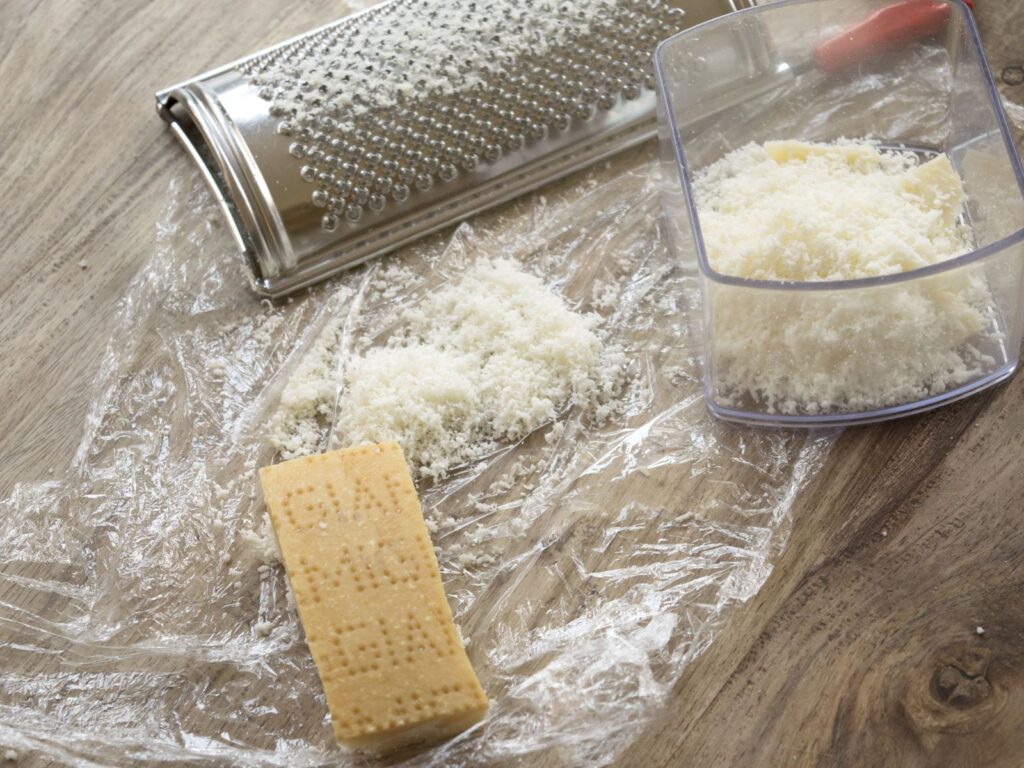
Finally, hard cheese like Parmesan, Pecorino and aged Cheddar can be wrapped in cheese paper or cheese bags and stored in the refrigerator. Actually, you can also pre-grate these cheeses and freeze them.
While we won’t recommend freezing cheese that you intend to serve on a board, this may be a suitable option for cheese that you intend to cook with.
Summary
Proper cheese storage is crucial to maintaining its flavour, texture and quality. General guidelines include storing cheese in the refrigerator, wrapping it in waxed paper or cheese-specific wrap, and storing it at a temperature between 4-8°C.
Different types of cheese require different storage methods, and equipment options include cheese grottoes and airtight containers. Remember to follow the guidelines specific to your region and the season to ensure your cheese stays fresh and delicious.
What’s your go-to option for storing cheese? Let us know in the comments below.




Fantastic tips.
Very helpful indeed. 👌